
Backstage at the CPW Closing Show by Jeremy W.
“Other duties as assigned”
“Other duties as assigned” is a concept well-known to admissions officers; it’s a catch-call term used by employers to encompass all the miscellaneous tasks an employee may be required to perform outside the scope of their stated job description. Of all of the other duties I’ve been assigned, running the CPW Closing Show is by far one of my favorites.
As many of you know, each April MIT Admissions hosts Campus Preview Weekend. During CPW, a thousand prefrosh descend upon the MIT campus to participate in more than 700 events over ~3.14 days—everything from How to Build an Underwater Robot and Extreme Karaoke to fire spinning and a Python bee. Think of CPW like the Olympic games, just with more math and fewer sports.
The same staff that is responsible for admitting students is responsible for hosting Campus Preview Weekend. So once decisions are out, the admissions office transitions out of Committee Mode and into Events Mode, carrying out all the logistics of CPW: transporting students from the airport, assigning students with an overnight host, orienting students to campus, and managing many of the weekend’s events.
While we have a dedicated internal team that oversees CPW planning (more on them later!), each member of the admissions staff has their own portion of CPW to oversee. For the last few years, my main CPW responsibility has been running the CPW opening and closing ceremonies, officially named the Admitted Student Welcome and the Closing Show, respectively. Coincidentally, I am part of a long legacy of admissions staff bloggers who have managed the CPW shows: Mikey ran the shows for many years, until DJ and I took over. Then it became the Jeremy and Kellen show, and eventually I enlisted Ceri and her unmatched Big Theater Kid Energy to help me.
This year, Ceri and I reached our most powerful form yet, adding Nikki to the team. This is a behind-the-scenes look at how the three of us we ran the 2024 CPW Closing Show.
Logistics
As the saying goes, “The road to showtime is paved with many logistical hurdles.” Months before we get to showtime in April, the opening/closing show team has to plan every aspect of the show: venue, staff, performances, rehearsals, sound, lights, safety, creative direction, and more. A combination of Trello, Google Sheets, and Slack helps us get the work organized.
This is just a selection of some of the tasks on our checklist leading up to the show:
- Formally reserve the performance space (Kresge Auditorium) from the MIT Campus Activities Complex
- Secure technical support and production managers for lighting design and audiovisual support
- Confirm participation of MCs, speakers, and any special guests
- Reach out to student performance groups and confirm their participation, length of performance, staging requirements, and lighting and sound needs
- Is playback audio needed?
- What is the stage setup? Do the performers need chairs, stands, or other props?
- Are the performers setting up the stage, or do they need assistance?
- Does the performance have timed lighting cues?
- Has the playback music been reviewed to make sure the content is appropriate?
- Organize a soundcheck and rehearsal for every performer
- Assign MIT Admissions staff to be “bouncers” and ushers for the event
- Bouncers have to be trained on the emergency protocol for the building, as well as accessibility features of the space, like the wheelchair lift
- Compile a final run-of-show document, outlining each performance, all lightning and sound cues, and stage directions
Kresge Auditorium
Securing the right venue is crucial. Because most of the students at CPW choose to attend the Closing Show, we need a venue that can accommodate an audience of over 1,000. On MIT’s urban campus, there are only a handful of spaces that can support such a large audience. Typically, we plan months in advance to reserve Kresge Auditorium (MIT’s main performance space) for the Closing Show.
(We’re not so lucky for the opening ceremony of the weekend, the Admitted Student Welcome. Since Kresge is typically already reserved for use by the Music & Theater Arts Department the day of the opening show, we must transform Rockwell Cage—a renovated United States Government airplane hangar-turned-gym—into makeshift event venue. MIT Campus Activities Complex works their magic to build us a temporary stage, set up a few stacks of bleachers, and arrange 700 chairs on the floor of the court, while MIT AV tackles the difficult task of designing a speaker setup in such a way that maximizes sound quality and minimizes echo of a massive airplane-hanger-turned-basketball-court.)
But for the Closing Show, we are blessed with Kresge. With 1,067 seats, a full lighting and sound booth, rehearsal rooms, an equipment lift, and backstage wings, Kresge is an ideal venue for our variety show. It’s also worth noting that Kresge is architecturally significant, a well-known work of celebrated Finnish-American architect Eero Saarinen.01 He’s the architect that designed the St. Louis Arch, the passenger terminal at Dulles International Airport in Washington, D.C., and the MIT Chapel! Dedicated in the 1950s, this mid-century modern masterpiece was one of the first large-scale applications of thin-shell concrete technology in the United States. Math nerds revel in the fact that Kresge’s reinforced concrete dome comprises one eighth of the surface of a sphere.
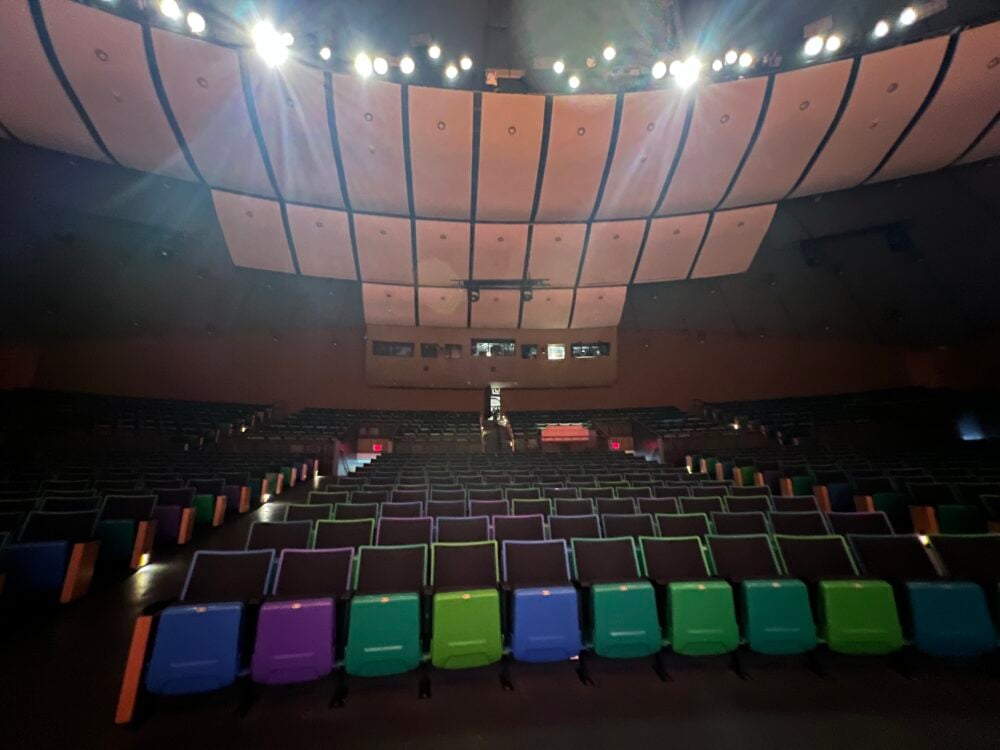
With a seating capacity of 1,067, Kresge Auditorium is MIT’s largest auditorium. An additional 157 seats can be added by eliminating stage space and arranging chairs in the front.
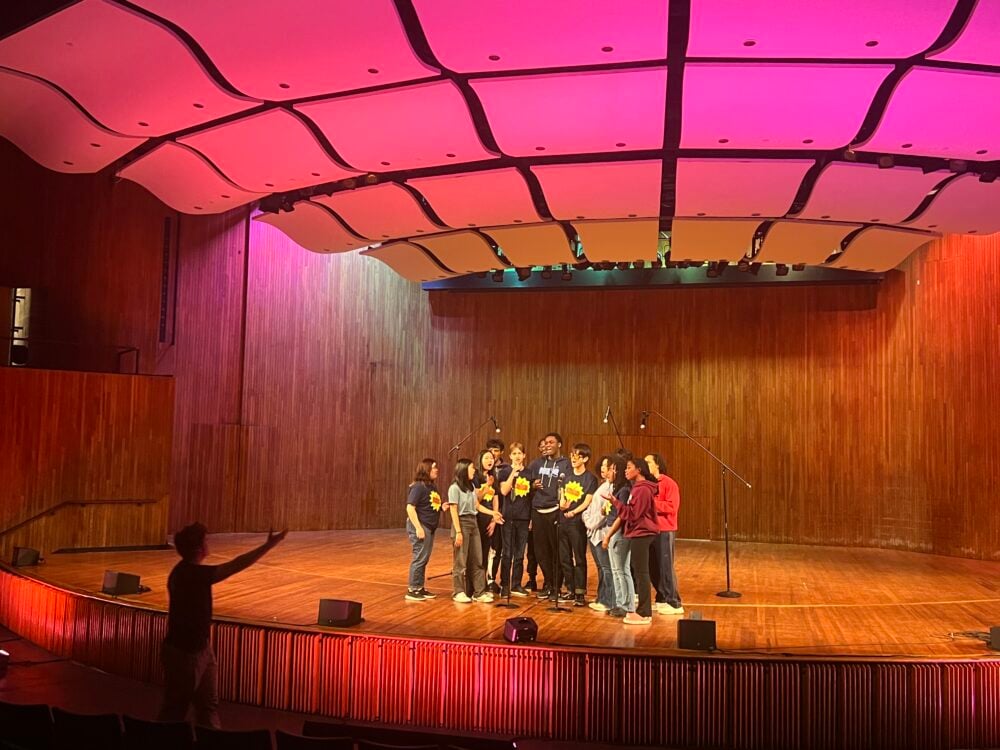
The MIT Logarhythms rehearse on Kresge Main Stage during soundcheck.
Backstage and the booth
Every production is made possible by the tech crew—and in the case of the Closing Show, we hire E33 Productions (an MIT student-run production group) to run lights, and MIT AV to run sound and manage the projector screens.
Here’s a peek into the Kresge tech booth during sound check, where you can see Zoma on lights, and Justin on sound:
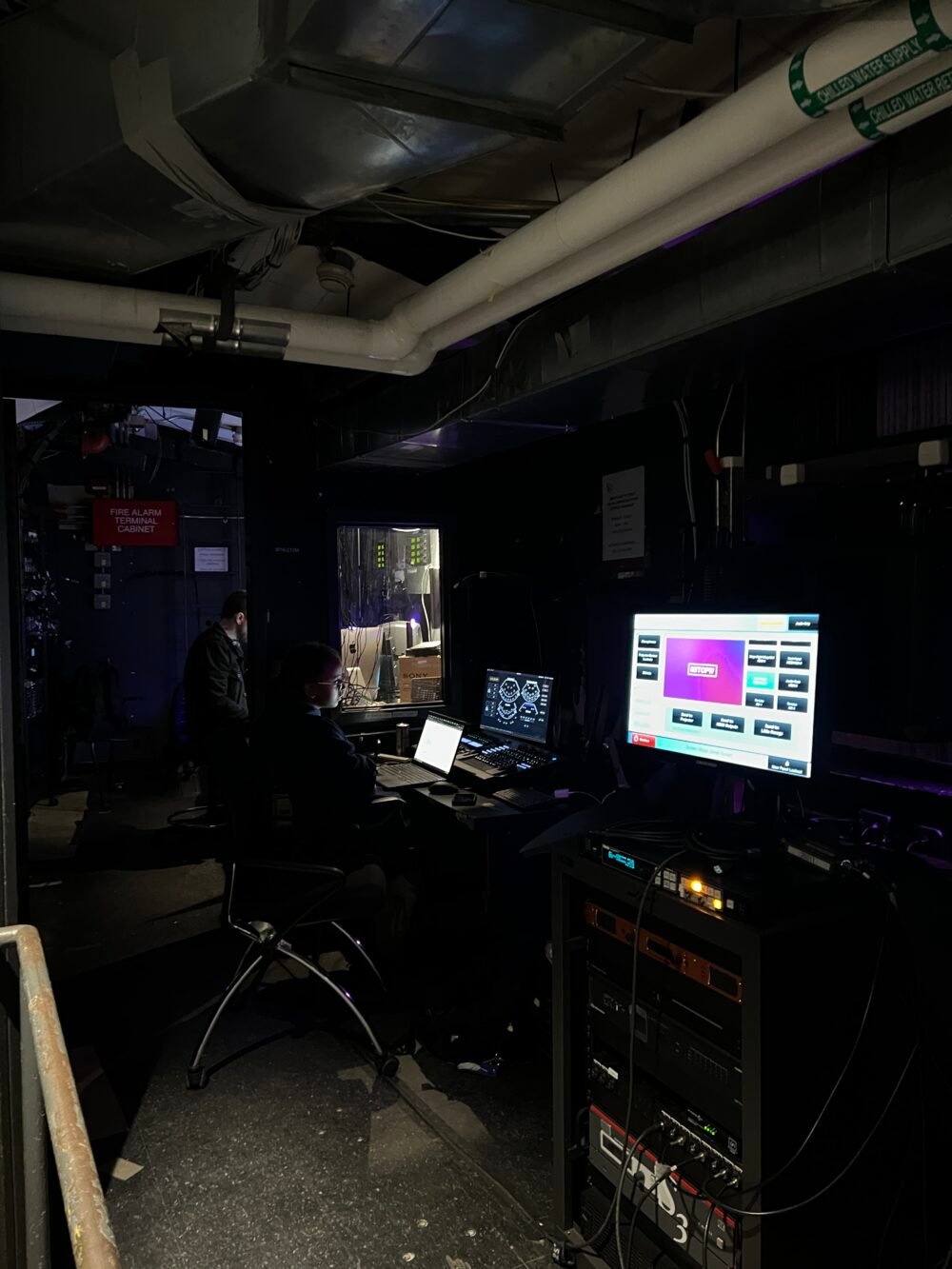
Shout out to Justin and Zoma for holding it down up in the booth.
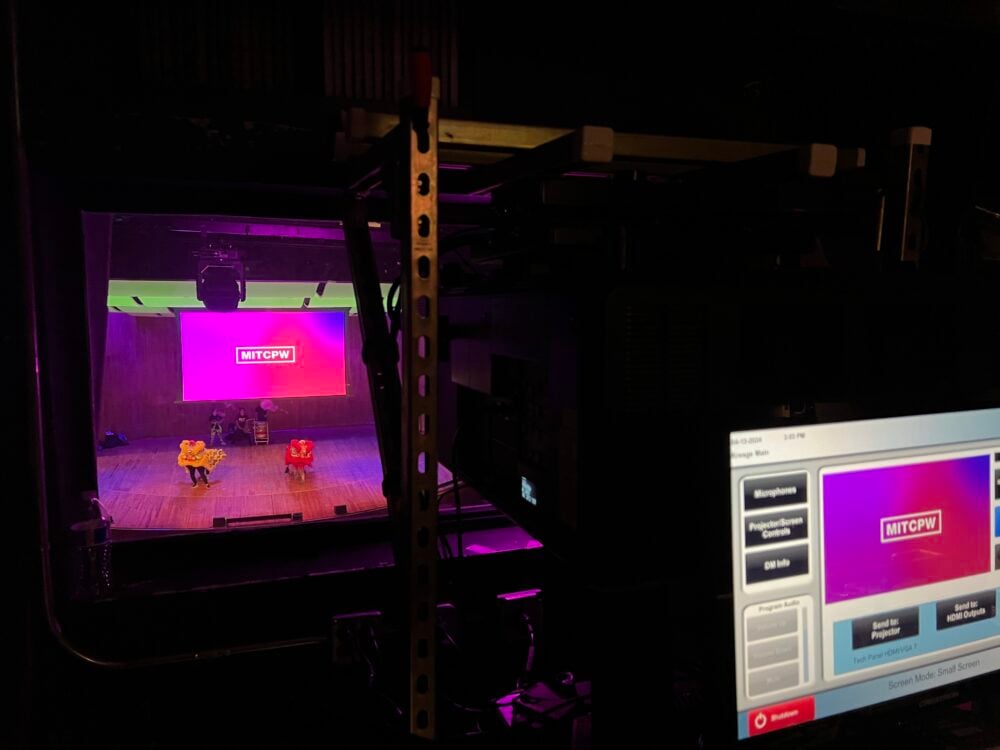
This is what the folks up in the booth see while MIT Lion Dance is rehearsing.
While the lighting and sound techs are up in the booth, Ceri, Nikki, and I are calling the show from backstage. Everyone refers to the run-of-show spreadsheet we put together, which provides minute-by-minute cues of all the moving parts of the show.
6:05 PM: Pi Day video plays on mid-stage screen (7 minutes runtime)
A/V: PiDayVideo2024.mp4 (video with sound)
Lights: Blackout while video plays
During the show, we communicate in real time between backstage and the booth using fancy wireless intercom system of beltpacks and headsets. While we mostly stick to what’s written in the run-of-show, having the headsets helps us communicate any unexpected changes, provide reminders, and ask for assistance.
“Lion Dance on deck…E33, blackout stage lights…cue lights for performance…run playback!”
Soundcheck is one of the most important steps in putting on a successful show. Six hours before showtime, Ceri, Nikki, and I posted up in Kresge while each group arrived for their scheduled rehearsal time. For groups like the Logarhythms, an a cappella ensemble, soundcheck is crucial to establish the correct balancing for their intricate microphone setup. And because each of their songs has a different sonic style and physical arrangement on the stage, adjustments need to be made between each piece. After a bunch of tweaks to their handheld and area mics, our sound guys had the Logs sounding great.
During the soundcheck for Video Game Orchestra, we positioned ourselves at various locations around the auditorium to offer feedback on how to balance the levels of the instruments. Even though I am not an expert on sound design, many years of being in musical ensembles actually came in handy, as I was able to help VGO adjust to the acoustics of the auditorium. It’s both an art and a science.
“We could use more strings, and less keys. Snare, can we have you at 75% volume? You’re drowning out the strings.”
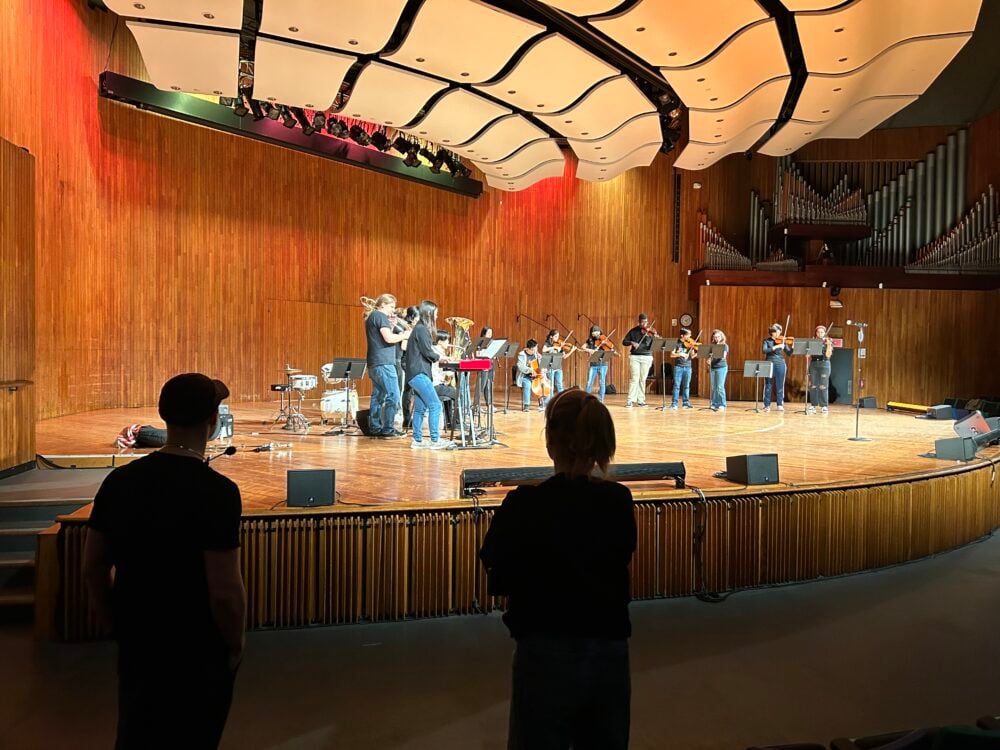
For other groups, soundcheck was less about sound, and more about the physicality of the stage. Some groups were familiar with the Kresge main stage, and for others, it was their first time performing there. For example, during the Mocha Moves dance rehearsal, their dance captain made repeated adjustments to expand their choreographed formations to fit the size of the Kresge stage. Their last performance had been in a much smaller venue, so this soundcheck game them the chance to adjust.
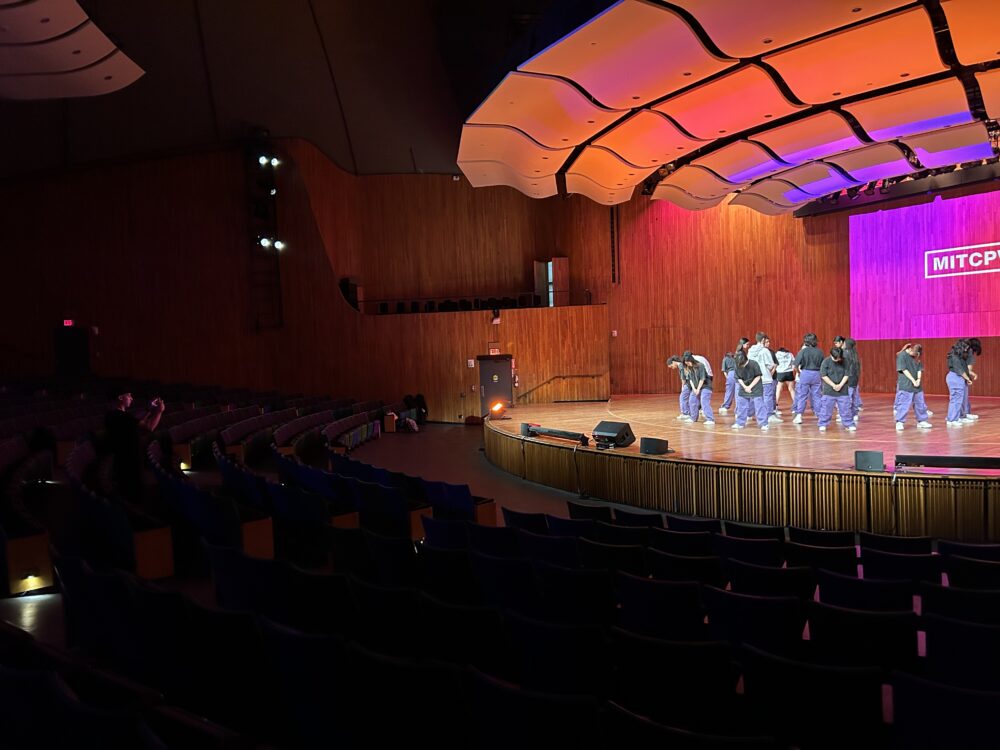
(Thank you, Ceri, for capturing me cosplaying Kris Jenner in the thank u, next music video off to the left.)
This may be obvious, but since we’re busy calling the shots from backstage, we don’t actually get to watch the show. In fact, with all these years running the shows, I’ve never actually had the chance to view the Closing Show from the audience. During the performances, our best chance to view what’s happening on stage is to sneak a glimpse from the side wings. Here’s my view of MIT Bhangra’s performance from the stage-right wing:
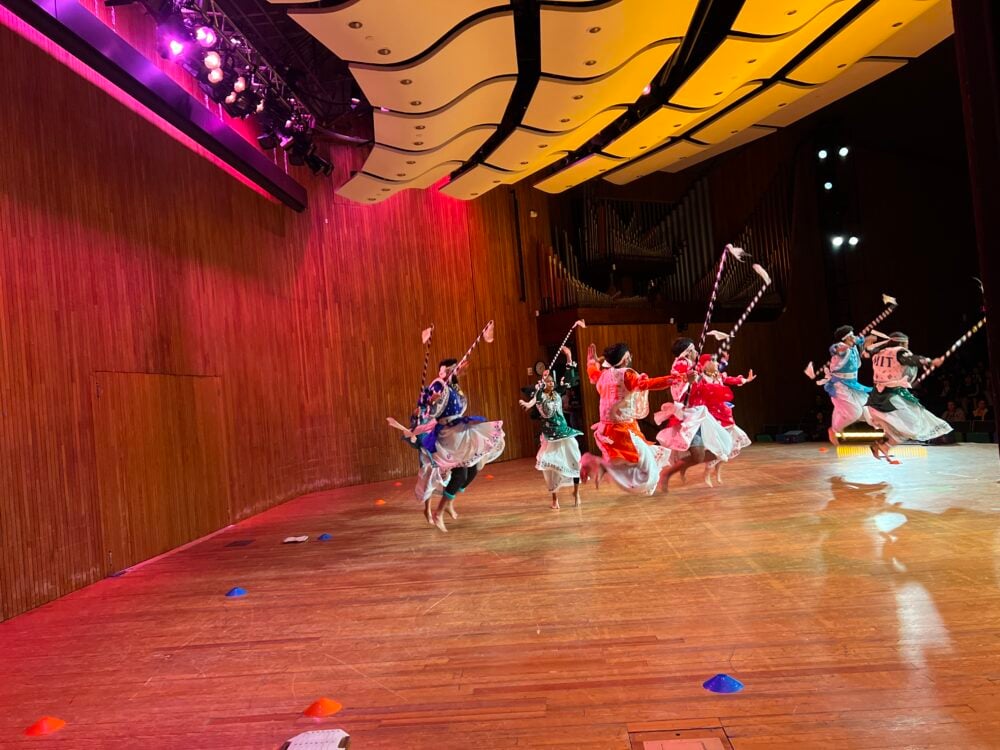
Setlist
We were fortunate to have a great slate of student performances this year that featured a broad range of talent within the MIT community. But with dozens of performance groups at MIT, it’s a always challenge to determine the final selection of performers. Ceri, Nikki, and I first met in January to discuss our options, and after weeks deliberation and coordination with various groups, we landed on this year’s show—a mix of music, dance, and cultural performance ensembles.
First, we decided to cold-open with a screening of this year’s epic Pi Day video, Beaverheimer. But instead of screening the normal version, we edited a special CPW edition that included a new surprise ending.
After the Pi Day video finished, we moved right into the first act: the MIT Video Game Orchestra making their CPW Closing Show debut! VGO graced us with live renditions of Coconut Mall from Mario Kart and Merry-Go-Round of Life from Howl’s Moving Castle. (Also, living legend and Tetris Champion Justin Yu is a member of VGO, so we were already huge fans!)
After VGO was done, our unparalleled duo of MCs, CPW coordinators Lauren and Trinidad, joined the stage to welcome the crowd. (To stay on theme with the Video Game Orchestra, Lauren and Trinidad came out on stage dressed in off-brand Mario and Luigi costumes. For legal reasons, their costumes were officially in the style of “Italian Plumber Brothers.” Scroll to the end for proof.)
The rest of the evening’s performers included:
- Rambax MIT kicked things off with an energetic, interactive performance of traditional Senegalese drumming rhythms
- Mocha Moves sustained the good vibes with a lively hip-hop dance routine. (As a Millennial, I have to admit that their mix included Timbaland’s The Way I Are, a classic from when I was in high school.)
- The MIT Logarhythms captivated us with an ambitious a cappella setlist: Don’t Lose Sight, Love on Top, and Here Comes the Sun.
- MIT Lion Dance stunned with an acrobatic performance of the traditional Chinese art form that blends dance, percussion, and ornate costumes.
- MIT Bhangra finished out the show with a high-octane performance that had me out of breath—just from watching!
- Of course, it wouldn’t be a CPW Closing Show without inviting the biggest star of them all: Dean Stu Schmill!
After Bhangra wowed us with their impressive cardiovascular endurance, we closed the show by announcing the winners of the annual CPW Meme Competition.02 This might warrant a blog post of its own… We invited the winners on stage to be officially crowned the memelords of MIT.
And with that, the 2024 Closing Show was a wrap. We started the day in Kresge at noon for soundcheck, 8 hours later we had put on a show! I want to thank Ceri and Nikki for being great collaborators on this year’s show, and Trinidad, Lauren, and Julianne (the CPW coordinators!) who made the entire weekend possible. A special thanks goes to the unsung heroes of the show, our technical staff up in the booth and backstage. Thank you, Zoma, Jim, and Justin.
I leave you with this exclusive photo of the 2024 CPW Closing Show team. Catch you backstage next year!

- He’s the architect that designed the St. Louis Arch, the passenger terminal at Dulles International Airport in Washington, D.C., and the MIT Chapel! back to text ↑
- This might warrant a blog post of its own… back to text ↑


